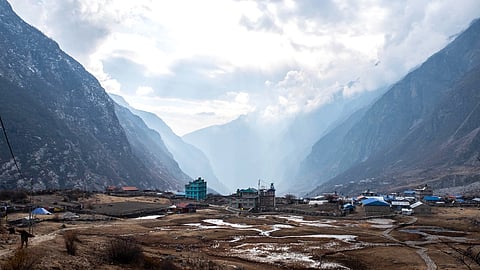How one village forged its own recovery after Nepal’s 2015 earthquake
THE PEOPLE of the Langtang Valley, in northern Nepal, regard their home to be a beyul – a hidden land, blessed as a sacred refuge by Padmasambhava, the 8th-century sage credited with bringing Buddhism to Tibet. A beyul, Tibetan Buddhists believe, is home to an abundance of biodiversity and natural resources, guarded by a host of protective spirits and deities. Tibetans fleeing persecution in their homeland have long sought shelter in these holy mountain sanctuaries.
Namgo-dagam, or the “Heavenly Gate of Half-Moon Form”, is one of Nepal’s most important beyuls. It lies in the Langtang Valley, near the border with Tibet. It is flanked by the mighty Langtang Lirung, a 7234-metre peak that is also the yulha, or the “god of the place”, considered the protector of Langtang. Ancient beliefs prescribe that timely and proper worship of Lirung will keep the valley and its community safe from harm.
Yet it was from the bowels of this mountain that the deadly avalanche which devastated Langtang in 2015 was born. At 11.56 am on 25 April 2015, a 7.8-magnitude earthquake struck Nepal, its epicentre some 70 kilometres west of here. On Lirung’s southern slope, the earthquake set off the fracture of a hanging block of glacier. As it fell thousands of metres, it dislodged more snow and ice, and gathered up huge amounts of silt and soil. Within minutes, millions of tonnes of debris buried almost the whole of Langtang village, the main settlement in the valley.
The avalanche released an air-blast of such power that it swept away buildings that had escaped the crush and uprooted a nearby forest of mature trees. Over the following days and weeks, more rocks plunged down and more avalanches pounded the valley. The geography of Langtang was transformed. Officially, 306 people died: at least 175 of the 370 or so locals present in the valley at the time; 82 Nepalis from other areas; and 49 foreign tourists. The locals said the death toll was closer to 500.
It is now ten years since the earthquake. The hordes of trekkers that have long been drawn here once again move up and down the Langtang Valley, enjoying the crisp air and impressive Himalayan vistas. Many, including myself, arrive eager to see how the people of Langtang have learned to live again – physically and spiritually – in their ancestral land. What lessons might they have for a world increasingly plagued by disaster?
In the first two weeks of March 2024, when I visited, the mornings were still cold; frost crunched underfoot and the surrounding mountains nursed a powdering of snow. I climbed persistently up and out of a river gorge forested with moss-clad trees until I emerged into the rocky valley, free of trees, coated with brown grass and tufts of green. Further on, the bright colours of the new Langtang village sat beneath a cloudless sky of royal blue, still in the shadow of Langtang Lirung.
The settlement had been rebuilt on a site above the original village. Its lanes are clean and orderly, the buildings concrete and square. At its edge sits an earthquake memorial – a grey stone stupa, crowned with a golden tower – symbolising death, loss and belief.
Below was an expanse of grey, where the avalanche and air-blast had stripped the land of its natural vegetation. Of the old village, only one building survived, nestled below a protective cliff. Boulders the size of minibuses dotted the dull slope. Buried beneath are homes, belongings, lives.

